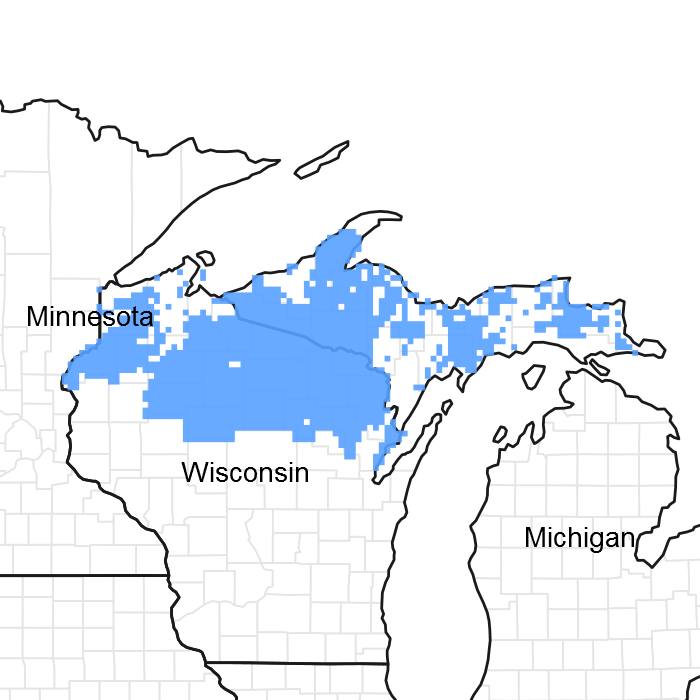
Natural Resources
Conservation Service
Ecological site F094DY004WI
Mucky Peat Bogs
Accessed: 12/17/2025
General information
Provisional. A provisional ecological site description has undergone quality control and quality assurance review. It contains a working state and transition model and enough information to identify the ecological site.

Figure 1. Mapped extent
Areas shown in blue indicate the maximum mapped extent of this ecological site. Other ecological sites likely occur within the highlighted areas. It is also possible for this ecological site to occur outside of highlighted areas if detailed soil survey has not been completed or recently updated.
MLRA notes
Major Land Resource Area (MLRA): 094D–Northern Highland Sandy Pitted Outwash
The Northern Highland Sandy Drift region (also referred to as MLRA 94D) lies mostly in northern Wisconsin with a few narrow outwash channels extending into the upper peninsula of Michigan. MLRA 94D encompasses 1.364 million acres and is surrounded by much larger, geologically different MLRAs. MLRA 94D is characterized mainly by sandy and gravelly soils formed in outwash sediments deposited by melt-water streams from late Wisconsin-Age glaciers, which receded from the area about 10,000 years before present (Attig 1985). The Mucky Peat Bogs ecological site occupies about 80,000 acres in MLRA 94D.
Classification relationships
This ecological site is one of four non-floodplain peatland ecological sites that are closely identified with MLRA 94D but occur beyond the borders of 94D. The soil components (all Histosols) found on this site occur across the northern tier of states from the northeast to the Midwest, as do other many peatland soil series. Most of Histosol soil series were first correlated in Michigan, as were some in Minnesota, but it was common practice to correlate these peatland soils across the widest extent possible, while accounting for local or regional variation in the map unit descriptions.
Ecological site concept
ATTENTION: This ecological site meets the NESH 2014 requirements for PROVISIONAL. A provisional ecological site is established after broad ecological site concepts are identified and an initial state-and-transition model is drafted. Following quality control and quality assurance reviews of the ecological site concepts, an identification number and name for the provisional ecological site are entered into ESIS. A provisional ecological site may include literature reviews, land use history information, some soils data, legacy data, ocular estimates for canopy and/or species composition by weight, and even some line-point intercept information. A provisional ecological site does not meet the NESH 2014 standards for an Approved ESD, but does provide the conceptual framework of soil-site correlation for the development of the ESD. For more information about this ecological site, please contact your local NRCS office.
The modal concept for Mucky Peat Bogs is a peatland that has highly acidic conditions but receives enough nutrients and drains well enough to produce a growing forest of black spruce (Picea mariana) and tamarack (Larix laricina). On this ecological site, Sphagnum moss thickness has not reached the level where access to nutrients is severely restricted as it is on Peat Bog ecological sites. Also, sufficient aeration of the root zone occurs on this site to allow for moderately productive tree growth for at least the aforementioned species. The resulting closed canopy forest can prevent Sphagnum moss from dominating the site, as those moss plants are shade intolerant. Also, the understory in general has fewer species compared to more nutrient-rich or open-canopy sites. The organic soils on this site have thin moss peat layer over well decomposed organic material of mainly herbaceous origin and the soil pH is below 4.5, an indication of low groundwater input from mineral uplands. However with abundant trees, nitrogen-fixing lichen habitat is increased, and therefore more productivity boosting nitrogen is leached into root zone from lichens on this site than on less densely forested sites.
Table 1. Dominant plant species
| Tree |
(1) Picea mariana |
|---|---|
| Shrub |
(1) Chamaedaphne calyculata |
| Herbaceous |
(1) Sphagnum magellanicum |
Click on box and path labels to scroll to the respective text.
